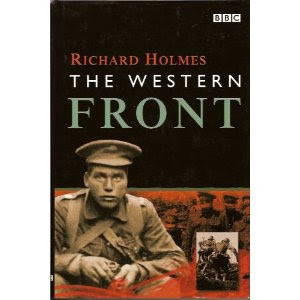 The Marne, 1914: The Opening of WWI and the Battle that Changed the World
The Marne, 1914: The Opening of WWI and the Battle that Changed the World, by Holger H. Herwig
Random House, 2009
319 pages plus 16 pages of b&w photos, acknowledgements, notes on sources, notes, index
Library: 940.421 HER
Description:
It is one of the essential events of military history, a cataclysmic encounter that prevented a quick GErman victory in World War I and changed the course of two wars and the world. Now, for the first time in a generation, here is a bold new account of the Battle of the Marne. A landmark work by a distinguished scholar,
The Marne, 1914 gives for the first time, all sides of the story. In remarkable detail, and with exclusive information based on newly unearthed documents, Holger M. Herwig superbly re-creates the dramatic battle, revealing how the German forces were foiled and years of brutal trench warfare were made inevitable.
Herwig brilliantly reinterprets GErmany's aggressive "Schlieffen Plan"-commonly considered militarism run amok-as a carefully crafted, years-in-the-making design to avoid a protracted war against superior coalitions. He also paints a new portrait of the run-up to the Marne: the Battle of the Frontiers, long thought a coherent assault but really a series of haphazard engagements that left "heaps of corpses", France demoralized, Belgium in ruins, and GErmany emboldened to take Paris.
Finally, Herwig puts in dazzling relief the Battle of the Marne itself: the French resolve to win, which included the exodus of 100,000 people from Paris (where even pigeons were placed under state control in case radio communication broke down), the crucial lack of coordination between Germany's First and Second Armies, and the fateful "Day of Rest" taken by the Third Army. He provides relevatory new facts about the all-important order of retreat by GErmany's Lieutenant Colonel Richard Hentsch, previously an event hardly documented and here freshly reconstructed from diary excerpts.
Herwig also provides stunning cameos of all the important players: Germany's Chief of GEneral Staff Helmuth von Moltke, progressively daring and self-pitying as his plans go awry, his rival, France's Joseph Joffre, seeming weak but secretly unflappable and steely, and Commander of the British Expeditionary Force John French, arrogant, combative and mercurial.
The Marne, 1914 puts into context the Battle's rich historical significance: how it turned the war into a 4-year-long fiasco that taught Europe to accept a new form of barbarism and stoked the furnace for the fires of World WAr II. Revalatory and riveting, this will be
the new source on this seminal event.
Table of Contents List of Maps
Prolgue: A drama never surpassed
1. War: Now or Never
2. "Let slip the dogs of war"
3. Death in the Vosges
4. The Bloody Road West: Liege to Louvain
5. Deadly Deadlock: The Ardennes
6. Squandered Climatics
7. To the Marne
8. Climax: the Ourcq
9. Decision: the Marne
Epilogue
Acknowledgments
Abbreviations
A Note on Sources
Notes
Glossary
Index
PhotosKaiser Wilhelm II
Helmuth vom Moltke, German chief of general staff
General Alexander von Kluck, chief of staff, GErman 1st army, General Kuhl, and 9 other unidentified officers
Erich Ludendorff, deputy chief of staff, German 2nd army
General Karl von Bulow, German 2nd army
Raymond Poincare, president of France
General Ferdinand Foch, French 9th army
General Edouard de Castelnau, French 2nd army
General Joseph P Joffre, French chief of general staff
General Fernand de Langle de Cary, French 4th army, Joffre, and unidentified officer
General Charles Lanrezac, commander French 5th army
General Auguste Yvon Edmond Dubail, French 1st army
Joseph Gallieni, governor of Fortress Paris
General Michael-Joseph Maunory
General Maurice Sarrail, French 3rd army
HH Asquith, prime minister of the UK
Horatio Herbert, Lord Kitchener, secretary of state for war and 2 unidentified men
Field Marshal John French, commander in chief British Expeditionary Force, and unidentified soldier and civilians
Field Marshal Douglas Haig
Field Marshal Sir HEnry Wilson, British deputy chief of staff
General Sir Horace Smith-Dorrien, British II corps
Fort Loncin, Liege, Belgium, 3 views
The library at Louvain (exterior, destruction)
___________________
Blog updated every Tuesday and Thursday






